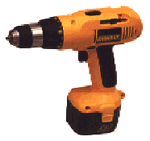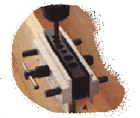
Cordless $130 upwards
Corded $100 upwards
Drill Press: $200 upwards
While cordless drills are ideal portable devices, they are not well suited to masonry work. If you intend to use the drill for a lot of non-wood drilling (particularly masonry) then you should purchase a corded drill. This is because cordless drills are not as powerful (the drill bit does not revolve as fast) and the battery will quickly drain if used to drill into brick. However, for the occasional masonry hole, cordless drills are still adequate.
Cordless drills come in many shapes and sizes. Voltages start as low as 4.8v and go up to around 18v. However, anything below 12v is not suitable as a power drill. Instead, these are really glorified screwdrivers. However, while more voltage means greater power, it also means that the drill will be heavier. Many people opt for the 12v model as being a happy compromise between weight and performance. There are two things to consider: how heavy the drill is and how well it is balanced. A well balanced drill will feel lighter in your hand than a lower voltage model that is unbalanced (i.e. the front is heavier than the back or vice versa). When holding the drill, it should not be an effort to point the drill bit in the direction that you want.
When choosing a drill you should consider the following things:
Drill presses are drills that are built into a stand, thus ensuring that all drill holes are at the correct angle (perpendicular to the wood's surface). However, although these ensure that drill holes are accurate, they are very inflexible devices. As such, drill presses are not necessary for the amateur woodworker and should be placed low down on the wish list. Besides which, there are techniques that will allow you to drill perpendicular holes without using a drill press (see below).
The hardest part of using a drill is ensuring that the hole is drilled at the correct angle (typically perpendicular to the surface). Most of the time, this can be achieved by roughly guessing as it does not matter too much. However, some drill applications (such as dowel joints) require a greater degree of accuracy.

In an attempt to help with this problem, some drills come with a built in spirit level. However, this is an over rated device (although it is useful for drilling into walls) and will not necessarily guarantee a perpendicular hole. For dowel joints, the best solution is to use a dowel jig. This jig (available from most hardware stores) ensures that the hole you are drilling is at the correct angle to the wood (see photo).
Drilling screw holes
When drilling screw holes, always make sure that the hole you drill is the same size, or slightly smaller, than the central, solid, stem of the screw. This will allow the flange of the screw to bite into the surrounding wood without the central solid stem having to force its way in. A hole that is too small may result in the screw splitting the wood.
Always use a counter sink drill bit to ensure that the head of the screw sits just below the surface of the wood. Again, the temptation is to allow the screw to find its own level, without using a counter sink, but this will lead to additional stress on the wood.